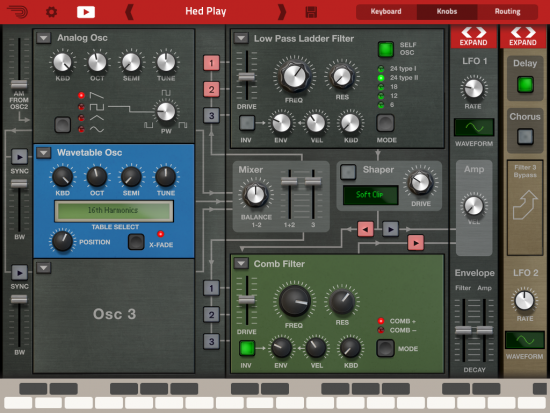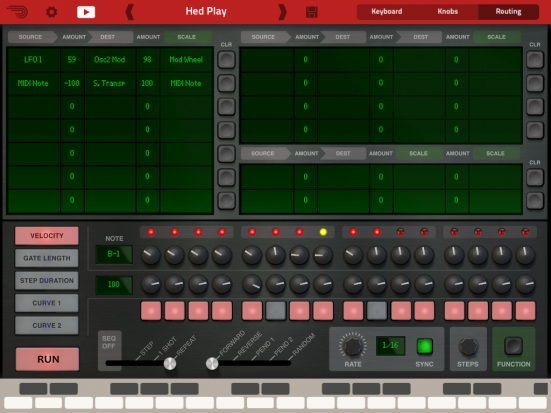First seen as the flagship synth for their desktop recording environment, Reason, Propellerhead Software recently released Thor for the iPad. A modular synthesizer with benefits, Thor is simply a must have for iPad musicians. I’ve never had more fun creating new synth patches with any other app, software plug-in, or hardware synth* for that matter.
Thor Polysonic Synthesizer for the iPad Features
- iPad Version of Classic Reason Synthesizer
- Contains over 1,000 Synth Patches
- Easy to Understand Modular Synth Architecture
- Patches Compatible with Reason 4.5
- Six Oscillator Types
- Four Filter Types
- Three Envelopes/Dual LFOs/Delay and Chorus
- Versatile Modulation Bus
- Step Sequencer Allows Odd Time Signatures
- Audiobus Compatible
- Normally Priced at $14.99 at the App Store
The app’s clear, intuitive interface makes it a joy to work with. And most importantly, its sound is top notch — rivaling that of the Moog Animoog, Waldorf’s Nave, or Arturia’s iMini.
A Modular Synth for the Masses
Thor’s synth architecture combines the power of modular synthesis with a measure of clarity that makes it easy to get right in and create your own patches. Sure, the app comes with over one-thousand patches which reveal both the breadth and depth of sonic possibilities, but it is just too much fun to roll your own sounds. When starting a new patch from scratch, the app wires up some common modular routings, allowing you to dive right into sound design.

The Knobs screen is where the meat of Thor programming lurks. Four panes cover oscillators, filters, envelopes, and effects — it is possible to have two panes expanded at all times. Thor sports three different oscillators with six different oscillator types: analog, multi, wavetable, FM, phase modulation, and noise. It is possible to ring modulate the two oscillators; the variety of sounds is nearly limitless.
Thor has three filters. Two are at the oscillator level with a variety of routings available on the Knobs screen. The third filter is global and affects the post-mixed sound. Four different filter types include Low Pass Ladder, State Variable, Comb, and Format. The latter works for adding vocal-like filtering.
A wave shaper adds to the sonic control capabilities, and a standard set of LFOs, envelopes, a mixer and effects round out the sound engine. What is really cool about Thor is the powerful modulation bus sharing its own screen with the step sequencer. It is possible to route practically any modulation source to a destination — both audio or control data. It is a breeze to use and opens up even more sonic possibilities.
Performing with Thor
Thor’s virtual keyboard includes a variety of features putting it near the top of the iPad synth world. Where you tap each key controls its velocity and swiping either up or down adds aftertouch. It is possible to scrunch or stretch the keys, highlight or filter them by key, and the strum feature is a great way to trigger guitar patches or even something weirder.

Thor provides step sequencer for each patch with up to 16 steps — emphasis on the “up to.” Yes, it is possible to do odd time signatures, so everyone can tap their foot in 15/16 or 5/8. By using the modulation bus to route the MIDI Note event to the sequencer’s transposition setting, you can use the virtual keyboard (or one externally connected using Core MIDI) to modulate the sequencer; just make sure you write the sequence in the key of C if you (or others) want to play along with the sequence in key (as Quarkspace discovered during one jam session).
Thor may in fact be the best iOS synth app for combining sonic power with a huge fun factor. Personally, I’ve never had this much joy creating my own synth patches — hardware, software, or tablet. This app belongs in the library of every iOS musician.
* — Note that I have a Moog Sub 37 on pre-order.

Pingback: Korg Gadget, Stroke Machine, and Thor all get Important iOS Updates | TabMuse -- a Home for Digital and Analog Music Inspiration